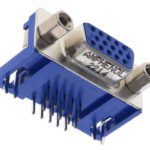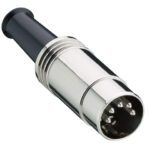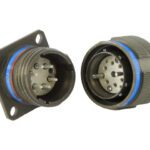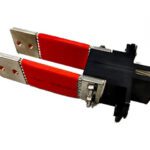What are OSFP transceivers?
Meet the Connector: OSFP Transceivers
Data centers support the IT infrastructure needed to run data-intensive applications and their ever-growing demand for storage. From remote work and streaming entertainment to decentralized finance and the connected devices that make up the Internet of Things, the need for 400G technology is here and the leap to 800G will be realized with small form factor pluggables such as OSFP.
The OSFP (octal small form factor pluggable) is a type of transceiver that connects a network device, such as a switch, to fiber or copper cable. It is one of two form factors for 400G access networks and data centers, along with QSFP-DD (quad small form factor pluggable-double density).
OSFP features eight high-speed electrical lanes that initially support 400 Gb/s (8x50G). It is slightly wider and deeper than the QSFP-DD, but it still supports 32 OSFP ports per 1U front panel, enabling 14.4 Tb/s per 1U.
This pluggable optical transceiver is designed with improved signal integrity and thermal performance. It will ease the upgrade from 400G to the next generation of 800G optics — eight lanes of 100 Gb/s (8x100G) for data centers and other mid-range reach applications. The modules are designed to manage up to 15 watts per port. The OSFP also offers backward compatibility with 100G QSFP optics. OSFP features integrated open or closed top heat sink fins as well as ventilation holes as defined in the specification.
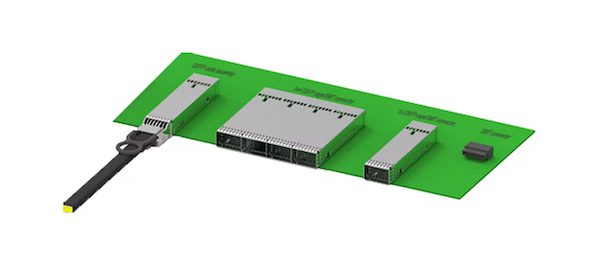
The Octal Small Form Factor Pluggable (OSFP) 112 Gbps PAM-4 Interconnect System and Cable Assemblies from Molex provide single-port, 8-lane I/O connectivity with DAC, AOC, ACC, and optical modules for high-density switch applications.
OSFP MSA
OSFP is developed by the OSFP MSA (multi-source agreement) group, founded by Google and led by Arista Networks. The OSFP MSA defines the OSFP specification, which encompasses the mechanical module, the card cage, the electrical interface, pinout, and management interface. The OSFPA MSA roadmap includes OSFP 112 G modules and cages providing system engineers with an 8 x 112 G PAM4 interconnect solution. This has already entered the market.
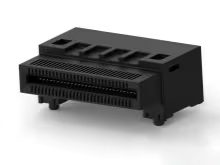
TE Connectivity’s OSFP pluggable I/O receptacle connector assembly has a 6 mm centerline pitch with surface mount as a PCB mounting style.
OFSP Transceiver Types
Current types of 400G OSFP transceiver optics: OSFP SR8, OSFP DR4, OSFP XDR4, OSFP PLR4, OSFP FR4, OSFP LR4, and OSFP 2FR4.
The OSFP-XD (extra dense) 1.0 pluggable specification was released March 17, 2023. The reduced profile of OSFP-XD offers increased I/O panel signal density and provides increased front panel cooling options yet will require trade-offs between higher panel density and lack of backward compatibility. The OSFP-XD module features 16 optical channels while offering the same faceplate connector density and doubling the signal density. The ability to support large capacity switches in a 1RU profile is highly desirable.
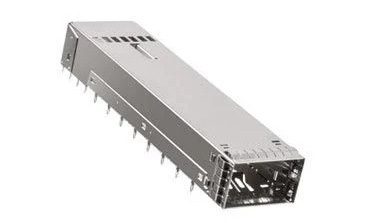
Amphenol’s OSFP interconnect system has 60 contacts per port, with a 0.6 mm contact pitch and eight high-speed channels. The OSFP footprint is optimized for signal integrity performance and built for use in high-speed serial applications. The connector is enhanced for low crosstalk and has ground commoning for resonance dampening. It is also designed for 1U applications. An integrated heat sink is featured on the module side for optimal thermal performance.
DESIGN NOTES
How to Specify
Choosing the right SFP transceiver depends on the application, cable type, optical range, and data transmission rate.
OSFP or QSFP-DD?
The two modules offer similar performance and profiles. Both provide eight channels at up to 50 Gb/s to meet current 400 Gb/s data rate demands. OSFP takes up more PCB space (32 OSFP ports can be mounted in the same space on a line card as 36 QSFP-DD ports). OSFP optic modules can handle up to 15 watts compared to 12 watts for QSFP-DD. OSFP features integrated heat sinks.
Suppliers – Amphenol Communications Solutions, Molex, Rosenberger, Samtec Inc., TE Connectivity
Related products
- QSFP+
- QSFP-DD
- SFP
Like this article? Check out our other Meet the Connector, our Datacom/Telecom Market Page, and our 2023 and 2022 Article Archive.
Subscribe to our weekly e-newsletters, follow us on LinkedIn, Twitter, and Facebook, and check out our eBook archives for more applicable, expert-informed connectivity content.
- Sealing Success: Overmolding for More Secure Connections - April 23, 2024
- Medical Cable Assemblies Product Roundup - April 23, 2024
- Mezzanine Connectors Product Roundup - April 16, 2024
